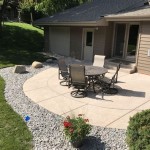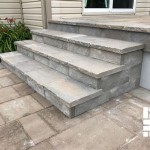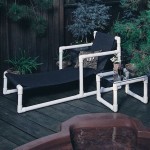How To Mix Concrete For a Patio
Creating a durable and aesthetically pleasing patio requires careful planning and execution, with one of the most crucial aspects being the proper mixing of the concrete. The strength, appearance, and longevity of the patio are directly influenced by the quality of the concrete mix. Understanding the correct ratios of ingredients, the mixing methods, and the factors that affect the concrete's properties is essential for achieving a successful project. This article provides a comprehensive guide to mixing concrete specifically for patio construction.
Understanding Concrete Mix Ingredients
Concrete is a composite material primarily composed of cement, aggregates (sand and gravel), and water. Each ingredient plays a vital role in determining the final characteristics of the concrete. The proportions of these ingredients must be carefully controlled to achieve the desired strength, workability, and durability.
Cement: Portland cement is the most common type used in concrete. It acts as a binder, chemically reacting with water to form a hardened matrix that holds the aggregates together. The type of cement selected can affect the setting time, strength, and resistance to various environmental factors. For patio applications, Type I Portland cement is generally suitable for most conditions. Type III cement might be preferred when quicker setting times and early strength are desired, while Type II or Type V may be used for improved sulfate resistance in areas with high sulfate content in the soil.
Aggregates: Aggregates constitute the bulk of the concrete mix, accounting for approximately 60-80% of the total volume. They are divided into fine aggregates (sand) and coarse aggregates (gravel or crushed stone). Sand provides workability to the mix by filling the voids between the larger gravel particles, and it contributes to the overall density and strength of the concrete. Gravel adds bulk and strength to the concrete, resisting cracking and shrinking. The size and gradation of the aggregates are crucial factors. A well-graded aggregate mix will have a range of particle sizes, ensuring that the voids are minimized, leading to denser, stronger concrete. Aggregate must be clean and free from any organic matter, clay, or other contaminants that could weaken the concrete.
Water: Water is essential for the hydration process, which is the chemical reaction between cement and water that causes the concrete to harden. The amount of water used is critical, as too much water weakens the concrete, while too little water makes it difficult to work with. The water should be clean and potable, free from harmful chemicals, oils, or other substances that could interfere with the hydration process. The water-to-cement ratio (w/c ratio) is a key parameter in concrete mix design. A lower w/c ratio (e.g., 0.4 to 0.5) generally produces stronger, more durable concrete, but it also reduces workability. A higher w/c ratio (e.g., 0.6 or higher) increases workability but reduces strength and increases the risk of shrinkage cracking.
Determining the Correct Concrete Mix Ratio
The mix ratio refers to the proportions of cement, sand, and gravel used in the concrete mix. A common mix ratio for concrete used in patios is 1:2:4 (cement:sand:gravel). This ratio can be adjusted based on specific requirements, but it provides a good starting point for achieving adequate strength and workability. Another common mix is 1:3:5. The specific ratio depends on factors like the desired strength, the type of aggregates used, and the environmental conditions. It is always better to err on the side of using a slightly richer mix (more cement) than a leaner mix.
Calculating Material Quantities: To determine the required amount of each ingredient, you first need to calculate the volume of concrete needed for the patio. This is done by multiplying the length, width, and thickness of the patio slab. Once the total volume of concrete is known, you can use the mix ratio to calculate the required amount of each ingredient. Remember to add 5-10% to account for waste and uneven slab thickness.
For example, let's assume you need 1 cubic yard (27 cubic feet) of concrete using a 1:2:4 mix ratio. The total parts in the ratio are 1 + 2 + 4 = 7. Therefore, you need 1/7 cubic yards of cement, 2/7 cubic yards of sand, and 4/7 cubic yards of gravel. Convert these fractions to cubic feet by multiplying by 27. This gives you approximately 3.86 cubic feet of cement, 7.71 cubic feet of sand, and 15.43 cubic feet of gravel. Convert these volumes to weight using bulk density information for each material.
Adjusting for Aggregate Moisture: The moisture content of the aggregates can significantly affect the water-to-cement ratio and the final properties of the concrete. Aggregates are often stockpiled outdoors and can absorb moisture from rain or humidity. If the aggregates are wet, you need to reduce the amount of water added to the mix to maintain the target w/c ratio. Determining the moisture content of the aggregates can be done using standard testing methods. A simple field test involves squeezing a handful of sand or gravel. If the material forms a ball that crumbles easily, it is likely surface dry. If water is visible, it is wet. If the sample holds a definite shape without visible water, it is likely damp. Compensate for surface moisture by reducing water additions accordingly. A ready-mix company will typically conduct moisture testing and adjust the mix accordingly.
Using Pre-Blended Concrete Mixes: Pre-blended concrete mixes are commercially available and offer convenience and consistency. These mixes contain a pre-determined ratio of cement, sand, and gravel, requiring only the addition of water. While this eliminates the need for measuring individual ingredients, it is still essential to follow the manufacturer's instructions carefully regarding water addition. Pre-blended mixes are suitable for smaller patio projects, but for larger projects, mixing concrete from individual ingredients may be more cost-effective.
Mixing Concrete: Methods and Best Practices
The mixing process aims to thoroughly blend the ingredients to create a homogenous and workable concrete mix. Concrete can be mixed manually or using a concrete mixer, depending on the size of the project.
Manual Mixing: Manual mixing is suitable for small quantities of concrete. It requires a sturdy surface, such as a mixing tray or a clean, non-absorbent surface. Start by thoroughly mixing the dry ingredients (cement, sand, and gravel) using a shovel, ensuring that they are evenly distributed. Gradually add water, mixing continuously until the concrete reaches the desired consistency. The concrete should be workable, but not too wet or soupy. Avoid adding too much water at once, as this can weaken the concrete. Over mixing is undesirable. The manual mixing process is labor-intensive and can be challenging for larger projects. Batching is crucial to ensuring each batch of concrete is roughly the same.
Using a Concrete Mixer: A concrete mixer is a mechanical device that automates the mixing process, making it easier to produce larger quantities of concrete. The mixer should be placed on a stable, level surface. First, add a portion of the water to the mixer, followed by the gravel, sand, and cement. Add the remaining water gradually until the desired consistency is reached. Allow the mixer to run for several minutes to ensure that the ingredients are thoroughly blended. Avoid overfilling the mixer, as this can reduce its efficiency. It is critical that all materials are adequately mixed. Proper use of a concrete mixer greatly improves concrete workability and consistency of each batch.
Consistency and Workability: The consistency of the concrete mix refers to its fluidity and resistance to flow. The desired consistency depends on the application. For patio slabs, a medium consistency is generally preferred. The concrete should be workable enough to spread and level easily, but not so fluid that it segregates or bleeds. Workability refers to the ease with which the concrete can be placed, consolidated, and finished. A workable concrete mix will hold its shape without slumping excessively. Test the concrete's consistency by performing a slump test. While a full slump test uses a cone and specific procedure, a crude test can be done by placing a trowel full of concrete on the ground and observing how much it slumps. If it collapses significantly or has pools of water on the surface, it's too wet. If it is very stiff and difficult to work, it is too dry. Adjust the water content accordingly in small increments to achieve the desired consistency.
Factors Affecting Concrete Setting Time: Several factors can influence the setting time of concrete, including the type of cement, the water-to-cement ratio, the temperature, and the use of admixtures. Higher temperatures accelerate the setting process, while lower temperatures slow it down. Certain admixtures, such as accelerators, can reduce the setting time, while others, such as retarders, can prolong it. It is essential to consider these factors when planning the concrete placement and finishing schedule. It is also important to consider the water temperature. Use cooler water in warmer temperatures in order to help prevent flash setting.
Safety Precautions: Working with concrete involves inherent risks, and it is important to take appropriate safety precautions. Always wear safety glasses, gloves, and protective clothing to prevent skin contact with wet cement. Concrete is highly alkaline and can cause chemical burns. Avoid breathing concrete dust, as it can irritate the respiratory system. Work in a well-ventilated area. When using a concrete mixer, follow the manufacturer's safety instructions and ensure that the mixer is properly grounded. Be aware of lifting hazards associated with heavy materials like cement and aggregate. Lift with your legs and avoid twisting your back.

How To Plan Pour Your Diy Concrete Patio Liberty Ready Mix

Quikrete Building A Concrete Patio

Diy Concrete Patio In 8 Easy Steps How To Pour A Cement Slab

Pour A Concrete Patio Entirely By Yourself Using Bag Mix Diy Project From Start To Finish

How To Mix Mortar For Patio Laying Bradstone

Types Of Concrete Mix For Any Project The Home Depot

Pour A Concrete Patio Entirely By Yourself Using Bag Mix Diy Project From Start To Finish

Quikrete Building A Concrete Patio

Pouring Concrete Patio What Could Go Wrong With Doing It Yourself

10 Steps To A Perfectly Stamped Concrete Patio K Supply
Related Posts








